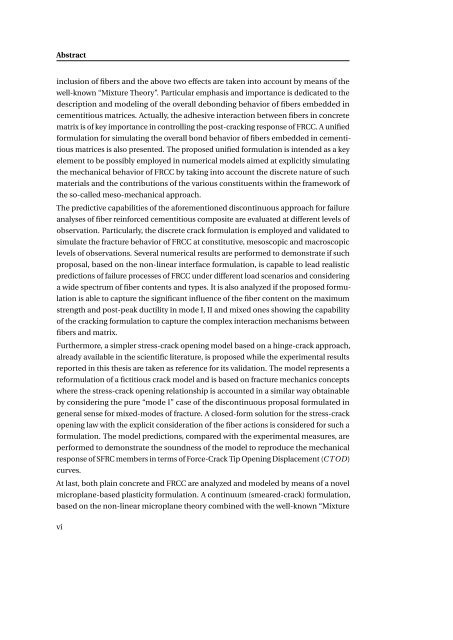tesi A. Caggiano.pdf - EleA@UniSA - Università degli Studi di Salerno
tesi A. Caggiano.pdf - EleA@UniSA - Università degli Studi di Salerno
tesi A. Caggiano.pdf - EleA@UniSA - Università degli Studi di Salerno
- No tags were found...
You also want an ePaper? Increase the reach of your titles
YUMPU automatically turns print PDFs into web optimized ePapers that Google loves.
Abstractinclusion of fibers and the above two effects are taken into account by means of thewell-known “Mixture Theory”. Particular emphasis and importance is de<strong>di</strong>cated to thedescription and modeling of the overall debon<strong>di</strong>ng behavior of fibers embedded incementitious matrices. Actually, the adhesive interaction between fibers in concretematrix is of key importance in controlling the post-cracking response of FRCC. A unifiedformulation for simulating the overall bond behavior of fibers embedded in cementitiousmatrices is also presented. The proposed unified formulation is intended as a keyelement to be possibly employed in numerical models aimed at explicitly simulatingthe mechanical behavior of FRCC by taking into account the <strong>di</strong>screte nature of suchmaterials and the contributions of the various constituents within the framework ofthe so-called meso-mechanical approach.The pre<strong>di</strong>ctive capabilities of the aforementioned <strong>di</strong>scontinuous approach for failureanalyses of fiber reinforced cementitious composite are evaluated at <strong>di</strong>fferent levels ofobservation. Particularly, the <strong>di</strong>screte crack formulation is employed and validated tosimulate the fracture behavior of FRCC at constitutive, mesoscopic and macroscopiclevels of observations. Several numerical results are performed to demonstrate if suchproposal, based on the non-linear interface formulation, is capable to lead realisticpre<strong>di</strong>ctions of failure processes of FRCC under <strong>di</strong>fferent load scenarios and consideringa wide spectrum of fiber contents and types. It is also analyzed if the proposed formulationis able to capture the significant influence of the fiber content on the maximumstrength and post-peak ductility in mode I, II and mixed ones showing the capabilityof the cracking formulation to capture the complex interaction mechanisms betweenfibers and matrix.Furthermore, a simpler stress-crack opening model based on a hinge-crack approach,already available in the scientific literature, is proposed while the experimental resultsreported in this thesis are taken as reference for its validation. The model represents areformulation of a fictitious crack model and is based on fracture mechanics conceptswhere the stress-crack opening relationship is accounted in a similar way obtainableby considering the pure “mode I” case of the <strong>di</strong>scontinuous proposal formulated ingeneral sense for mixed-modes of fracture. A closed-form solution for the stress-crackopening law with the explicit consideration of the fiber actions is considered for such aformulation. The model pre<strong>di</strong>ctions, compared with the experimental measures, areperformed to demonstrate the soundness of the model to reproduce the mechanicalresponse of SFRC members in terms of Force-Crack Tip Opening Displacement (C T OD)curves.At last, both plain concrete and FRCC are analyzed and modeled by means of a novelmicroplane-based plasticity formulation. A continuum (smeared-crack) formulation,based on the non-linear microplane theory combined with the well-known “Mixturevi
















